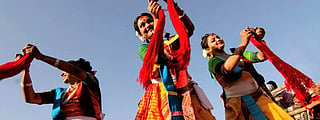
Did you know that in some parts of India, Holi is played with flowers instead of colours? Or that in Punjab, it's marked by fierce displays of martial arts? In Goa, it takes the form of grand street parades, while in Kerala, people smear each other with turmeric instead of gulal!
Holi may be known as the Festival of Colours, but its celebrations are as diverse as the country itself, blending mythology, culture, and local traditions. Here are 10 unique ways India celebrates this vibrant festival.
Bihar’s Phalgun Purnima brings Holi to life with a raw and rustic charm, blending age-old traditions with unfiltered joy. The celebrations kick off with soulful folk songs and crackling bonfires, setting the stage for a festival steeped in culture. Gujiyas, malpuas, and other traditional sweets add to the festive spirit, while the energetic play of colours transforms the streets into a vibrant canvas.
West Bengal’s Basant Utsav adds an artistic and cultural charm to Holi, with people dressing in bright yellow to welcome spring. The celebrations feature graceful dance performances, soulful music, and the traditional Dola Yatra, a joyous procession of song and dance. Nowhere is the spirit of this festival more vibrant than in Shantiniketan, blending festivity with poetry, art, and heritage.
In Kerala, Holi transforms into a radiant celebration with Manjal Kuli, also known as Ukuli. Instead of coloured powders, people joyfully smear each other with turmeric paste mixed with water, symbolising purity and prosperity. The festivities are accompanied by energetic folk music and traditional songs, creating a vibrant yet distinct Holi experience that bathes everything in a warm, golden glow.
In Vrindavan, Holi takes a divine turn with Phoolon Ki Holi, where clouds of vibrant flower petals fill the air instead of coloured powders. Celebrated at the revered Banke Bihari Temple, this enchanting tradition pays homage to Radha and Krishna, drawing devotees and visitors into a world of music, chants, and floral showers. The temple doors open briefly for the grand petal offering, creating a surreal and spiritual experience that sets the tone for the larger Holi festivities across the region.
Shigmo Utsav in Goa is a dazzling spring festival that blends tradition with festivity. Over two weeks, the state bursts into life with energetic street processions, lively folk dances, and dramatic reenactments of legends. The celebration extends to the coastline, where brightly decorated boats reflect the joy of the season, making it a truly unforgettable experience.
In Maharashtra, Holi is celebrated with a unique flair through Rang Panchami, honouring Krishna Leela. The festivities include vibrant pandals, spirited human pyramids for the traditional matki phod (pot breaking), and joyful splashes of colours and water, making it a lively and energetic affair.
Jaipur’s Holi celebrations are nothing short of grand. The City Palace hosts an opulent event where both locals and tourists can immerse themselves in the festivities. The city comes alive with Dhulandi Holi, a colourful celebration at the renowned Govind Dev Ji Temple, and the spectacular Elephant Festival, featuring decorated elephants, traditional performances, and lively processions. These vibrant traditions make Jaipur one of the most exciting places to experience Holi in all its glory.
Manipur’s Yoasang festival is a five-day-long celebration that blends Holi with indigenous traditions. It starts with the burning of a thatched hut, symbolising the triumph of good over evil. Children go from house to house asking for donations. The festival concludes with grand festivities featuring colours, traditional music, and energetic dance performances, making it one of the most vibrant Holi celebrations in India.
Unlike the usual playful Holi, Punjab’s Hola Mohalla is a show of strength and bravery. The Sikh community marks the three-day festival with martial arts performances, mock battles, and horse-riding displays at Anandpur Sahib. The fest is usually observed in Anandpur, located in the Rupnagar district of Punjab.
The festival was introduced by Guru Gobind Singh as a way to instil courage and unity among Sikhs. It’s a unique fusion of tradition, warrior spirit, and Holi’s vibrant hues, making it a spectacular event to witness.
Holi in India takes on many forms, each with its own unique traditions yet united by the spirit of joy and togetherness. This year, a historic moment will unfold in Vrindavan, where over 2,000 widows will come together to celebrate Holi, breaking centuries-old societal taboos. Organised by social organisations and the UP Tourism Department, the ‘Widows’ Holi 2025’ aims to set a Guinness World Record, symbolising a step towards inclusion and empowerment.
The initiative challenges the long-standing belief that widows should refrain from festive celebrations, encouraging them to embrace colours, joy, and a sense of belonging
To get all the latest content, download our mobile application. Available for both iOS & Android devices.